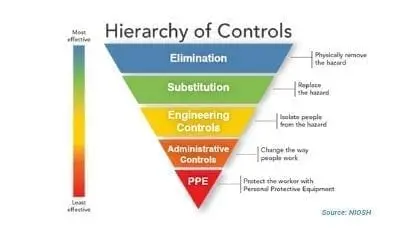What are Risk Control Measures?
Risk control measures are strategies implemented to mitigate or manage the potential risks and hazards that may arise in various activities, processes, or environments. After identifying and assigning a risk rating to a hazard, effective risk controls should be implemented to protect workers. Working through a hierarchy of controls can be an effective method of choosing the right control measure to reduce the risk.
5 Risk Control Measures
Below is the National Institute for Occupational Safety and Health’s Hierarchy of Controls—composed of elimination, substitution, engineering controls, administrative controls, and PPE—that can help guide you in the process of formulating your organization’s risk control measures.
Elimination
Elimination is the most effective hierarchy of risk control. If it is possible to physically remove a hazard, it must be done.
Substitution
Substitution is the second most effective control. It proposes to replace the hazard with a safer alternative, e.g. automating a manual process identified as dangerous, buying a newer equipment model with better safety ratings, etc.
Engineering controls
Engineering controls refer to physically isolating people from the hazard if at all possible.
Administrative controls
Administrative controls refer to changing the way people work. This may include procedural updates, additional training, or increasing the visibility of precautionary signs and warning labels.
PPE
Personal Protective Equipment (PPE) is the last line of defense if workers cannot be completely removed from a hazardous environment.

OSHA recommends the following guidelines to accomplish hazard control
Improve your GRC management
Simplify risk management and compliance with our centralized platform, designed to integrate and automate processes for optimal governance.
Explore now- Eliminate or control all serious hazards immediately.
- Use interim controls while you develop and implement longer-term solutions.
- Select controls according to a hierarchy that emphasizes engineering solutions (including elimination or substitution) first, followed by safe work practices, administrative controls, and finally personal protective equipment.
- Avoid selecting controls that may directly or indirectly introduce new hazards.
- Review and discuss control options with workers to ensure that controls are feasible and effective.
- Use a combination of control options when no single method fully protects workers.



